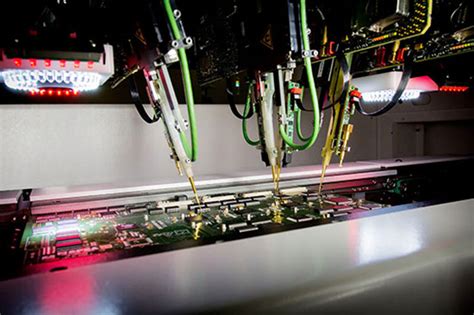How Flying Probe Testing Works
Flying probe testers utilize multiple moving test probes to make contact with test points on a PCB. The probes are mounted on high-precision, computer-controlled robotic arms that can quickly move to different locations on the board. Here’s a step-by-step overview of the flying probe testing process:
- PCB Loading: The PCB is loaded into the flying probe tester either manually or through an automated system.
- Fiducial Recognition: The tester uses fiducial marks on the PCB to accurately align the board and determine the locations of test points.
- Probing: The flying probes move to the programmed test points and make contact with the PCB. The number of probes can vary depending on the tester model and configuration.
- Electrical Testing: The tester performs various electrical tests, such as continuity, isolation, and component verification, by applying signals and measuring responses through the probes.
- Fault Detection: If any faults or defects are detected during the testing process, the tester logs the information and may provide a graphical representation of the issue.
- Reporting: Once the testing is complete, the tester generates a detailed report containing the test results, any detected faults, and other relevant information.
Advantages of Flying Probe Testing
Flying probe testing offers several key advantages over traditional bed-of-nails testing:
- Flexibility: Flying probe testers can easily adapt to different PCB designs and layouts without requiring custom fixtures. This flexibility saves time and cost when testing low-volume or prototype boards.
- No Fixture Required: Unlike bed-of-nails testing, flying probe testing does not require a dedicated test fixture. This eliminates the cost and lead time associated with designing and manufacturing custom fixtures.
- High Test Coverage: Flying probes can access test points that may be difficult or impossible to reach with a bed-of-nails fixture, resulting in higher test coverage and improved fault detection.
- Fast Setup: Programming a flying probe tester is generally faster than designing and building a custom test fixture, allowing for quicker test setup and shorter time-to-market.
- Ideal for Low-Volume Production: Flying probe testing is particularly well-suited for low-volume production runs, prototypes, and boards with frequent design changes, as it eliminates the need for costly fixture updates.
Limitations of Flying Probe Testing
Despite its many advantages, flying probe testing does have some limitations:
- Slower Than Bed-of-Nails: Flying probe testing is generally slower than bed-of-nails testing, as the probes must move between test points. This makes it less suitable for high-volume production.
- Limited Simultaneous Testing: Most flying probe testers have a limited number of probes, typically ranging from 4 to 8. This limits the number of simultaneous tests that can be performed, unlike bed-of-nails testers, which can have hundreds or thousands of probes.
- Probe Wear: The constant movement and contact of the flying probes can lead to wear over time, requiring periodic maintenance and replacement.
- Accessibility Challenges: Some components or test points may be difficult for flying probes to access, such as those located in tight spaces or near tall components.

Flying Probe Tester Configurations
Flying probe testers come in various configurations to suit different testing requirements. Here are some common configurations:
| Configuration | Number of Probes | Typical Application |
|---|---|---|
| Single-Sided | 2 – 4 | Simple PCBs, low-volume production |
| Double-Sided | 4 – 8 | Complex PCBs, medium-volume production |
| Multi-Station | 8 or more | High-complexity PCBs, high test coverage |
Flying Probe Testing vs. Bed-of-Nails Testing
When deciding between flying probe testing and bed-of-nails testing, consider the following factors:
| Factor | Flying Probe Testing | Bed-of-Nails Testing |
|---|---|---|
| Test Coverage | High | High |
| Setup Time | Fast | Slow |
| Test Speed | Slow to Medium | Fast |
| Fixture Cost | None | High |
| Flexibility | High | Low |
| Volume | Low to Medium | High |
| Probe Wear | Yes | No |
| Accessibility | Limited | Good |
Frequently Asked Questions (FAQ)
- What types of tests can flying probe testers perform?
Flying probe testers can perform a wide range of electrical tests, including: - Continuity testing
- Short-circuit testing
- Open-circuit testing
- Resistance measurement
- Capacitance measurement
- Diode and transistor testing
-
Voltage measurement
-
How long does it take to program a flying probe tester?
Programming a flying probe tester is generally faster than designing and building a bed-of-nails fixture. The programming time depends on the complexity of the PCB and the specific tests required, but it can range from a few hours to a few days. -
Can flying probe testers detect all types of PCB defects?
Flying probe testers can detect most common PCB defects, such as open circuits, short circuits, and component failures. However, they may have limitations in detecting some defects, such as those related to mechanical issues or high-frequency performance. -
How much does a flying probe tester cost?
The cost of a flying probe tester can vary widely depending on the configuration, number of probes, and additional features. Entry-level systems can start at around $50,000, while high-end, multi-station testers can cost several hundred thousand dollars. -
Are flying probe testers suitable for high-volume production?
Flying probe testers are generally better suited for low to medium-volume production, prototypes, and boards with frequent design changes. For high-volume production, bed-of-nails testing is typically more efficient due to its faster test speed and ability to perform simultaneous tests.
Conclusion
Flying probe testing is a versatile and powerful technique for testing PCBs, offering flexibility, high test coverage, and fast setup times. While it may not be the best choice for every situation, it is an invaluable tool for low to medium-volume production, prototypes, and boards with frequent design changes. By understanding the advantages, limitations, and key considerations of flying probe testing, you can make an informed decision when selecting a PCB Testing method for your specific needs.






Leave a Reply